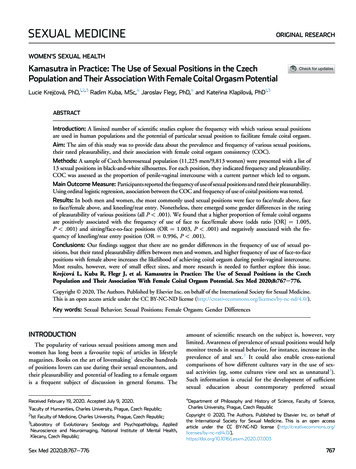
Transcription
ORIGINAL RESEARCHWOMEN'S SEXUAL HEALTHKamasutra in Practice: The Use of Sexual Positions in the CzechPopulation and Their Association With Female Coital Orgasm PotentialLucie Krej cová, PhD,1,2,3 Radim Kuba, MSc,4 Jaroslav Flegr, PhD,4 and Kate rina Klapilová, PhD1,3ABSTRACTIntroduction: A limited number of scientific studies explore the frequency with which various sexual positionsare used in human populations and the potential of particular sexual position to facilitate female coital orgasm.Aim: The aim of this study was to provide data about the prevalence and frequency of various sexual positions,their rated pleasurability, and their association with female coital orgasm consistency (COC).Methods: A sample of Czech heterosexual population (11,225 men/9,813 women) were presented with a list of13 sexual positions in black-and-white silhouettes. For each position, they indicated frequency and pleasurability.COC was assessed as the proportion of penile-vaginal intercourse with a current partner which led to orgasm.Main Outcome Measure: Participants reported the frequency of use of sexual positions and rated their pleasurability.Using ordinal logistic regression, association between the COC and frequency of use of coital positions was tested.Results: In both men and women, the most commonly used sexual positions were face to face/male above, faceto face/female above, and kneeling/rear entry. Nonetheless, there emerged some gender differences in the ratingof pleasurability of various positions (all P .001). We found that a higher proportion of female coital orgasmsare positively associated with the frequency of use of face to face/female above (odds ratio [OR] ¼ 1.005,P .001) and sitting/face-to-face positions (OR ¼ 1.003, P .001) and negatively associated with the frequency of kneeling/rear entry position (OR ¼ 0.996, P .001).Conclusions: Our findings suggest that there are no gender differences in the frequency of use of sexual positions, but their rated pleasurability differs between men and women, and higher frequency of use of face-to-facepositions with female above increases the likelihood of achieving coital orgasm during penile-vaginal intercourse.Most results, however, were of small effect sizes, and more research is needed to further explore this issue.Krej cová L, Kuba R, Flegr J, et al. Kamasutra in Practice: The Use of Sexual Positions in the CzechPopulation and Their Association With Female Coital Orgasm Potential. Sex Med 2020;8:767e776.Copyright 2020, The Authors. Published by Elsevier Inc. on behalf of the International Society for Sexual Medicine.This is an open access article under the CC BY-NC-ND license ).Key words: Sexual Behavior; Sexual Positions; Female Orgasm; Gender DifferencesINTRODUCTIONThe popularity of various sexual positions among men andwomen has long been a favourite topic of articles in lifestylemagazines. Books on the art of lovemaking1 describe hundredsof positions lovers can use during their sexual encounters, andtheir pleasurability and potential of leading to a female orgasmis a frequent subject of discussion in general forums. TheReceived February 19, 2020. Accepted July 9, 2020.1Faculty of Humanities, Charles University, Prague, Czech Republic;21st Faculty of Medicine, Charles University, Prague, Czech Republic;3Laboratory of Evolutionary Sexology and Psychopathology, AppliedNeuroscience and Neuroimaging, National Institute of Mental Health,Klecany, Czech Republic;Sex Med 2020;8:767e776amount of scientific research on the subject is, however, verylimited. Awareness of prevalence of sexual positions would helpmonitor trends in sexual behavior, for instance, increase in theprevalence of anal sex.2 It could also enable cross-nationalcomparisons of how different cultures vary in the use of sexual activities (eg, some cultures view oral sex as unnatural3).Such information is crucial for the development of sufficientsexual education about contemporary preferred sexual4Department of Philosophy and History of Science, Faculty of Science,Charles University, Prague, Czech RepublicCopyright ª 2020, The Authors. Published by Elsevier Inc. on behalf ofthe International Society for Sexual Medicine. This is an open accessarticle under the CC BY-NC-ND license ).https://doi.org/10.1016/j.esxm.2020.07.003767
768behavior, and moreover, these findings could provide publichealth professionals with up-to-date information about partnered sexual behaviors and thus help develop adequate treatment strategies to increase the level of sexual wellbeing inindividuals as well as couples.Existing studies tend to focus on the prevalence and/or frequency of particular heterosexual sexual behaviors, especially ongiving and receiving oral sex, vaginal intercourse, and anal sex.4e7National sex surveys reveal a wide variation in heterosexualpractices. A recent Czech survey found that 85% of women and91.2% of men had in their lifetime engaged in vaginal intercourse, app. 55% of women and 67% of men have experiencewith receiving oral sex, and 20% of women and 27% of menengaged in insertive anal sex.8 In Australia, the proportion ofmen and women who had in their lifetime experienced vaginalintercourse is 92%,7 while in the United States, the proportionstands at 91% for women and 86% for men.4 For oral-genitalsex, these figures stand at 67% for women and 78% for menin Australia and 77% of women and 81% of men in the UnitedStates. Lifetime experience with receptive anal sex was reportedby 15% of women in Australia and 37% of women in the UnitedStates, whereas for insertive anal sex, these figures stood at 21%of men in Australia and 36% of men in the United States.Kinsey et al9,10 in his classical reports on sexual behavior of theUS population lists the following ranking of frequency of use of 7coital positions in men and women: male above, female above,side, rear entrance, sitting, and standing. Swieczkowski andWalker11 investigated preferences for and the frequency of use ofvarious sexual positions in young married women in the UnitedStates. With respect to positions and practices relevant to ourstudy, they arrived at the following ranking of frequency of use:face to face/male above, fellatio, face to face with female above,cunnilingus, face to face side position, prone rear entry, sitting faceto face, kneeling rear entry, sitting rear entry, and anal sex. Theyalso found that the frequency of use of sexual positions highlycorrelated with individual preference for a given position and theposition’s rated effectiveness in producing female orgasm.Various research in human populations shows that sexualpositions have varying effects on female orgasm potential. Arepresentative survey of Swedish women12 assessed the use ofvarious sexual techniques and associations between the techniques and orgasmic function. A major predictor of Swedishwomen’s orgasmic function was a wider repertoire of sexualtechniques used, such as manual and oral stimulation, or the useof dildo during sexual activity. In noncoital activities, the prevalence of women who reached orgasm by manual genitalcaressing was 75e89% and by cunnilingus 61e73%, wherebyproportions differed depending on the age category. Duringpenile-vaginal intercourse, 51e57% women were able to reachorgasm solely by penile movements in the vagina, and almost50% of women reported they could reach orgasm withoutclitoral stimulation. This Swedish study unfortunately did notspecify the coital positions.Krej cová et alTo date, links between orgasmic experience and specific coitaland noncoital activities were reported only by Swieczkowski andWalker,11 who asked women how often they experienced orgasmduring various sexual activities. Answers were indicated on a40-point Likert scale (with ends verbally anchored as “not at all”and “exclusively” and the range in-between divided in 8 segments, each with 5 further subdivisions). Mean ratings orderedthe positions as follows: face to face male above (28), face to facefemale above (26.36), manipulation of female genitals by partner(23.47), cunnilingus (17.94), face to face side position (16.73),stimulation of breasts and other nongenital areas (11.69), sittingface to face (10.78), prone rear entry (8.23), kneeling rear entry(5.85), sitting rear entry (3.81), stimulation by vibrator (2.26),and anal intercourse (0.89).Awareness of differences in the effectiveness of various sexualpositions for achievement of female orgasm is also mirrored insexual therapy. Eichel, De Simone Eichel, and Kule13 introducedthe coital alignment technique, an effective sexual techniquedesigned to boost female orgasmic ability. This coital positioncombines the standard missionary position with coordinatedsexual movements. In particular, the male pubic bone and penisbase rub against women’s clitoris, so the position combinesvaginal penetration with constant stimulation of the clitoris. Theefficiency of coital alignment technique was confirmed by severalsubsequent studies (for a review, see the article by Pierce14).AIMSThe aim of the present study is to provide evidence on theunderresearched area of usage of various sexual positions inheterosexual men and women during sexual intercourse. Existingstudies tend to focus on the prevalence/frequency of vaginal intercourse, oral sex, or anal sex irrespective of the position used. Inthis study, we want to address this gap in existing knowledge. Weexplore gender differences in the rated pleasurability of varioussexual positions and investigate associations between coital positions used, age, frequency of sexual activities, and coital orgasmconsistency (COC) in women. Based on previous studies, wepredict that women with higher COC would be older, withhigher monthly frequency of sexual activities, and would useface-to-face sexual positions during sexual intercourse over thepast 5 years more often.MATERIALS AND METHODSSample and ProcedureThe methods and description of the electronic survey “SexualPreferences and Behaviors Inventory 2015” are described indetail elsewhere.15 In brief, data were collected between January2015 and March 2018 via an online questionnaire distributed byQualtrics (www.qualtrics.com). Participants were recruited viaadvertisements placed at a Facebook page and in the media. Onlyparticipants older than 15 years were allowed to take the questionnaire. Participants were informed about the aims of the studySex Med 2020;8:767e776
769Sex Positions and Female OrgasmFigure 1. Sexual positions. A ¼ Face to face/male above; B ¼ Prone rear entry; C ¼ Standing/face to face; D ¼ Standing; E ¼ Face to face/female above; F ¼ Supine/female above; G ¼ Fellatio/standing; H ¼ Kneeling/rear entry; I ¼ Sitting/face to face; J ¼ Standing/rear entry;K ¼ Cunnilingus; L ¼ Sixty-nine; M ¼ Fellatio/female above.on the first page of the electronic survey. Those who agreed toparticipate, pressed the “Next” button (n ¼ 48,407) and wereasked about their sexual experiences, preferences, and behaviors.Ethical ConsiderationsAll participants received information about the purpose of thestudy and confidentiality of all information they would provideand gave us their informed consent for participation in the studyonline. No reward was disbursed for participation in the study.The study was approved by the Institutional Review Board of theFaculty of Science, Charles University, Czech Republic (No.2015/01).These sexual positions were chosen based on previous studies9e11and a Czech book on the art of lovemaking widely used in therapeutic practice in the Czech Republic.16 Respondents assessedtheir experience with the use of these positions by answering thefollowing questions: (i) “How often did you engage in the followingsexual position over your lifetime?” (indicated on a 7-point verballyanchored ordinal scale: 1 ¼ Never, 2 ¼ Once or twice, 3 ¼ At most5 times, 4 ¼ At most 15 times, 5 ¼ At most 30 times, 6 ¼ At most100 times, 7 ¼ More frequently); (ii) “Was it pleasurable?” (indicatedon ordinal 4-point scale ranging from 1 ¼ Not at all to 4 ¼ Verypleasurable); (iii) “Please estimate the percentage of sexual encounters inthe past 5 years when you used a particular position” (indicated on acontinuous scale from ranging from 0% to 100%).MeasuresFor the purpose of our study, we used questions pertaining tosociodemographic information and sexual behavior.Sociodemographic CharacteristicsSociodemographic data included information about the yearof birth, sex (male, female), education, and relationship status(single or having a partner).Sexual orientation was assessed by the following question: “Doyou consider your sexual orientation homosexual rather than heterosexual?” Responses were indicated using a 7-point Likert scale,with 1 corresponding to “Definitely not”, 7 to “Definitely yes”, andthe in-between range indicated by a numerical scale. As our aimwas to study sexual behavior in heterosexual individuals, participants scoring from 4 to 7 (n ¼ 2,156) and respondents who didnot respond to this question (n ¼ 25,213) were excluded fromfurther analyses. Monthly mean frequency of penile-vaginal intercourse over the past year was assessed on a scale ranging from1 to 8 (1 ¼ Not even once, 2 ¼ Once, 3 ¼ Twice or three times,4 ¼ 4e6 times, 5 ¼ 7e10 times, 6 ¼ 11e20 times, 7 ¼ 21e30times, 8 ¼ More than 30 times).Questions on the Use of Sexual PositionsThe questionnaire included visual black-and-white silhouettesdepicting 13 sexual positions (9 coital, 4 noncoital; Figure 1).Sex Med 2020;8:767e776Assessment of COCTo assess the percentage of coital activities resulting in orgasm,women answered the following question: “Please indicate thepercentage of penile-vaginal intercourse which led to orgasm elicitedsolely by coital movements with the current partner?” Respondentsindicated their answer using a 6-point scale (1 ¼ Never,2 ¼ 5e25%, 3 ¼ 25e50%, 4 ¼ 50e75%, 5 ¼ 75e95%,6 ¼ Almost always).Statistical AnalysisBefore running a statistical analysis, we filtered out 1% of ourdata exceeding 3 standard deviations in the following variables:age and duration of the test.We used IBM SPSS Statistics 21 (SPSS Inc, Chicago, IL) forall statistical analyses. P values .05 were considered statisticallysignificant. First, we counted the descriptive data on the prevalence, pleasurability, and frequency of use of the 13 sexual positions we followed. For prevalence assessment, participants’responses on the frequency of particular positions over lifetimeand in the past 5 years were converted to a binary variable: 0 ¼not used at all (1/0%) and 1 ¼ used (2e7/1e100%). Toexamine gender differences in the frequency of use, both overlifetime and in the past 5 years, and pleasurability of sexualpositions, we performed a nonparametric Mann-Whitney test.Significant between-group differences were explored and
770Krej cová et alTable 1. Demographic characteristics of the sampleVariableAge (in years)*Education (%)PrimaryVocationalSecondaryGraduate degreeRelationship (%)YesLength of relationship(in years)*Sexual orientation (%)†1 (Not at all)23Monthly mean frequency ofsexual activities*,‡Men(N ¼ 11,225)Women(N ¼ 9,813)35.87 (11.9)30.9 (10.6)2.96.843.4475.73.046.944.474.47.9 (9.7)73.15.4 (7.6)88.99.61.5482.314.13.64.3Missing values excluded.*Mean value (SD).†Participants answers to the question “Do you consider your sexual orientation homosexual rather than heterosexual?“ Answers indicated on thefollowing scale: 1 ¼ Definitely Not to 7 ¼ Definitely Yes.‡Answers indicated on the following scale: 1 ¼ Not even once, 2 ¼ Once,3 ¼ Twice or Three times, 4 ¼ 4e6 times, 5 ¼ 7e10 times, 6 ¼ 11e20 times,7 ¼ 21e30 times, 8 ¼ More than 30 times.qualified by calculating effect sizes using Cohen’s d coefficient.17To explore associations between the COC, frequency of use of 9coital positions during intercourse over the past 5 years, age, andthe mean frequency of sexual activities, we performed ordinallogistic regression analyses (enter method with COC as adependent variable).RESULTSOur final sample included a total of 21,038 Czech men(n ¼ 11,225) and women (n ¼ 9,813) aged 18e86 years. Themean age was 35.87 (SD ¼ 11.93) for men and 30.9(SD ¼ 10.57) for women. Demographic characteristics of thesample are presented in Table 1.Heterosexual men and women both reported that the mostfrequently used sexual positions are face to face/male above(A), face to face/female above (E), and kneeling/rear entry (H).As shown in Table 2, however, we found significant genderdifferences between heterosexual men and women in the frequency of use of particular sexual positions over lifetime (Thiswas the case for 9 out of 13 positions we investigated). Heterosexual men reported the use of a number of positions,especially prone rear entry (B), standing/face to face (C),standing (D), face to face/female above (E), sitting/face to face(I), cunnilingus (K) and sixty-nine (L), significantly more thanheterosexual women did. Among heterosexual women, positions fellatio/standing (G) and kneeling/rear entry (H) werereported to be used more frequently than by heterosexual men.Cohen’s d, however, shows that the effect size of these resultswas either very small or negligible.Median frequencies of sexual positions used over the past5 years are shown in Figure 2. Not surprisingly, the same 3positions reported as most frequently used over lifetime alsoshowed up as the most frequently used over the past 5 years: faceto face/male above (A; median 80% for both sexes), face to face/female above (E; median 40% for both sexes), and kneeling/rearentry (H; median 38% for men, 42% for women). Several othergender differences also appeared in the frequency of use ofvarious positions over the past 5 years (Table 3), but their effectsizes were too small to be of interest.We found significant gender differences in the pleasurability ofall 13 positions (all P .001) (Table 4). The largest differenceswere found in positions where men receive oral sex (G, fellatio/standing; M, fellatio; L, sixty-nine), but the effect size indicated asmall effect. The smallest difference was found in the face to face/male above position (A).Table 5 provides an overview of the proportion of sexualencounters resulting in female orgasm during various positionsinvolving penile-vaginal intercourse with a stable partner. Interestingly, almost one-third of women reported that they neverexperienced orgasm during coitus with their stable partner.To examine which sexual positions best predicted the occurrence of orgasm during coitus (assessed as COC), we performedan ordinal regression analysis (enter method). Note that whilethere are 6 response ordinal categories, 5 cutoff points (thresholds) were created. A reference category was determined as theone with the highest ordered level. In this case, Y ¼ 6 (ie, COCis almost always) was considered a reference category. In Table 6,the model shows that COC with a current partner was significantly predicted by older age (OR ¼ 1.021, P .001), highermonthly mean frequency of sexual activity (OR ¼ 1.119,P .001), higher frequency of use of face to face/female above(OR ¼ 1.005, P .001) or sitting/face-to-face position(OR ¼ 1.003, P .001), and a lower frequency of kneeling/rearentry position (OR ¼ 0.996, P .001).DISCUSSIONThe aim of our study was to provide data about theprevalence and frequency of use of various sexual positions, toassess rated pleasurability of these positions, and to test theirassociation with COC. Overall, the study presents descriptivedata about a lifetime and 5-year frequency of the use of 9coital and 4 noncoital positions. In both men and women,face to face/male above, face to face/female above, andkneeling/rear entry were reported as the most commonly usedpositions. Our study revealed a number of gender differencesin the frequency of use of particular positions across the CzechSex Med 2020;8:767e776
771Sex Positions and Female OrgasmTable 2. Lifetime prevalence of the use of sexual positions and gender differences in the frequency of their use among heterosexual menand womenLifetime prevalenceMenWomen†PositionN%*Mdn (M)n%*Mdn (M)†Z‡Cohen’s dA ¼ Face to face/male aboveB ¼ Prone rear entryC ¼ Standing/face to faceD ¼ StandingE ¼ Face to face/female aboveF ¼ Supine/female aboveG ¼ Fellatio/standingH ¼ Kneeling/rear entryI ¼ Sitting/face to faceJ ¼ Standing/rear entryK ¼ CunnilingusL ¼ Sixty-nineM ¼ Fellatio/female 5.189.086.889.87633636654656 1.81 4.24** 4.12** 14.83** 5.01** 1.50 8.56** 2.70* 2.78* .43 15.59** 9.92** ing values excluded.*P .01; **P .001.*Binary value.†Median for “How often did you experience this position?” (1 ¼ Never, 2 ¼ 1 to 2 times, 3 ¼ At most 5 times, 4 ¼ At most 15 times, 5 ¼ At most 30 times,6 ¼ At most 100 times, 7 ¼ More frequently).‡Z score for Mann-Whitney U test.In both men and women, face to face/male above and face toface/female above were the 2 most common sexual positionsexperienced both over lifetime and in the past 5 years, a findingwhich is in line with earlier research.9,10 These positions allowface-to-face contact and facilitate continued facial as well as oralcommunication between partners during sex. Recognition ofpartner’s sexual pleasure during a particular sexual position canincrease its use in dyadic sexual repertoire, and moreover, face-toface positions make it possible for partners to kiss and hug eachother, which can further intensify sexual pleasure.Median % of sexual encounters in the pastfive yearspopulation, but owing to relatively small effect sizes and anonrepresentative sample, the results must be interpreted—andespecially generalised—with caution. We found a number ofgender differences in the rating of pleasurability of particularpositions, where men rated positions where the male receivesoral sex (fellatio, sixty-nine) as more pleasurable than womendid. Higher COC was positively associated with the frequencyof use of face to face/female above and sitting/face-to-faceposition and negatively predicted by the kneeling/rear DEFGHIJKLMSexual PositionsFigure 2. Median frequency of sexual positions used by heterosexual men and women in the past 5 years.Sex Med 2020;8:767e776
772Krej cová et alTable 3. Prevalence of the use of sexual positions in the past 5 years and gender differences in frequency in heterosexual men and womenPast 5 years prevalenceMenWomen†PositionN%*Mdn (M)n%*Mdn (M)†Z‡Cohen’s dA ¼ Face to face/male aboveB ¼ Prone rear entryC ¼ Standing/face to faceD ¼ StandingE ¼ Face to face/female aboveF ¼ Supine/female aboveG ¼ Fellatio/standingH ¼ Kneeling/rear entryI ¼ Sitting/face to faceJ ¼ Standing/rear entryK ¼ CunnilingusL ¼ Sixty-nineM ¼ Fellatio/female 83.389.883.791.3803041040526421510301040 2.58* 11.19** 0.34 8.40** 1.39 0.22 11.29** 8.34** 5.48** 2.04* 13.64** 5.63** .19)(37.57)(20.49)(44.73)Missing values excluded.*P .01. **P .001.*Binary value.†Median (mean) for the percentage of sexual encounters when the position was used in the past 5 years (from 0% to 100%).‡Z score for Mann-Whitney U test.Not surprisingly, we confirmed that in Czech, sample positions with oral-genital contact are also frequently used. In fact,the proportions we found are even higher than those reportedin previous foreign4,7 and Czech studies.8 This could be atleast in part due to the lower mean age of our sample incomparison to samples used in population surveys: A number ofstudies reported that the percentage of noncoital activities tendsto be higher in people in their twenties, peaking in theirthirties.4,7,18Although we found several gender differences in the reportedprevalence and frequency of use of sexual positions, small effectsizes indicate that these differences are of marginal importance.From a theoretical point of view, there was no reason to expectstrong gender differences. Our analysis was limited to a heterosexual population, and given that the 2 sexes engage in sexualactivities together, frequencies of use of particular sexual positions in a representative population sample should be closelyaligned.8Table 4. Gender differences in rated pleasurability of sexual positionsMenWomenPositionnMean ranknMean rankZCohen's dA ¼ Face to face/male aboveB ¼ Prone rear entryC ¼ Standing/face to faceD ¼ StandingE ¼ Face to face/female aboveF ¼ Supine/female aboveG ¼ Fellatio/standingH ¼ Kneeling/rear entryI ¼ Sitting/face to faceJ ¼ Standing/rear entryK ¼ CunnilingusL ¼ Sixty-nineM ¼ Fellatio/female 40,746841,71 3,66** 12,95** 13,85** 14,34** 19,48** 22,53** 24,92** 34,1** 39,34** 40,64** 50,1** 54,34** ing values excluded.**P .001.Sex Med 2020;8:767e776
773Sex Positions and Female OrgasmTable 5. Percentage of coitus with partner resulting in orgasm(in %)COCWomen (n ¼ 7,450)Never5e25%25e50%50e75%75e95%Almost always32.421.69.810.513.712.0COC ¼ coital orgasm consistency.Missing values excluded.Nevertheless, an examination of differences in the pleasurability of sexual positions indicates that women tend to ratepositions with deep vaginal stimulation as the most pleasurable,whereas men tend to rate fellatio as the most pleasurable. Oralpenis contact received lower pleasurability ratings in women,and positions involving it showed the highest gender differencein ratings. This can be explained by reluctance to manipulate andswallow semen19 as well as women’s higher vigilance in terms ofhygiene and negative sexual health outcomes.20 Despite thisdiscrepancy between the sexes, positions involving oral-peniscontact were reported by both men and women as frequentlyused. This contrast between rated pleasurability and frequencycould be influenced by insufficient communication betweenpartners about their sexual preferences,21 by women’s highersusceptibility to their partner’s needs, or even by pornographicmaterials where fellatio is one of the most commonly appearingpractices, which may create the impression that it ought to be anintegral part of each sexual intercourse.22 These speculations are,however, merely preliminary because the scale used for ratingpleasurability in the current project was not sensitive enough(4-point scale). Particularly in the male sample, this resulted in aceiling effect. In future studies, a more sensitive scale should beused.One-third of women reported they had never experiencedorgasm during coitus with their partner. This result may be dueto nonrepresentative sampling because a representative sample ofCzech women showed that only 21.9% never had a vaginalorgasm.23 The higher numbers of respondents willing to shareintimate and possibly uncomfortable information (such asabsence of orgasm in women) could be at least in part accountedfor by online sampling, which offers a higher perceived level ofanonymity than for instance the use of computer-assisted personal interviewing or face-to-face interviewing methods.24Although two-thirds of women can experience orgasm duringcoitus, one-third do so less than half the time. In our study, wedid not investigate possible associations between psychologicaland relationship-related factors on the one hand and the frequency of COC (for a review, see studies by Meston et al andBrody25e27) on the other hand to further elucidate thesefindings.Associations between the COC and frequency of use ofparticular coital positions during intercourse suggest that womenTable 6. Results for the ordinal logistic regression model predicting coital orgasm consistency (COC) in womenWomenVariableb (SE)Age (years)Monthly mean frequency of sexual intercourseA ¼ Face to face/male above†B ¼ Prone rear entry†C ¼ Standing/face to face†D ¼ Standing†E ¼ Face to face/female above†F ¼ Supine/female above†H ¼ Kneeling/rear entry†I ¼ Sitting/face to face†J ¼ Standing/rear entry†Thresholds1 (Never)2 (5e25%)3 (25e50%)4 (50e75%)5 (75e95%).021.112.000.000.002.002.005 .001 28112,87130,14495% 002/1.005.999/1.003 .001** .001**.507.504.081.067 .001**.183 .001** /15.64324.582/36.929OR ¼ odds ratio; SE ¼ standard error.Missing values excluded listwise. Nagelkerke’s R2 ¼ 0.084.**P .001.*95% CI for OR.†Frequency scale 0e100%. Dependent variable: COC with a current partner (1 ¼ Never, 2 ¼ 5e25%, 3 ¼ 25e50%, 4 ¼ 50e75%, 5 ¼ 75e95%, 6 ¼ Always).Sex Med 2020;8:767e776
774Krej cová et alwho are older, engage in heterosexual intercourse more often,and use f
Mean ratings ordered the positions as follows: face to face male above (28), face to face female above (26.36), manipulation of female genitals by partner (23.47), cunnilingus (17.94), face to face side position (16.73), stimulation of breasts and other nongenital areas (11.69), sitting face to face (10.78), prone rear entry (8.23), kneeling rea.










